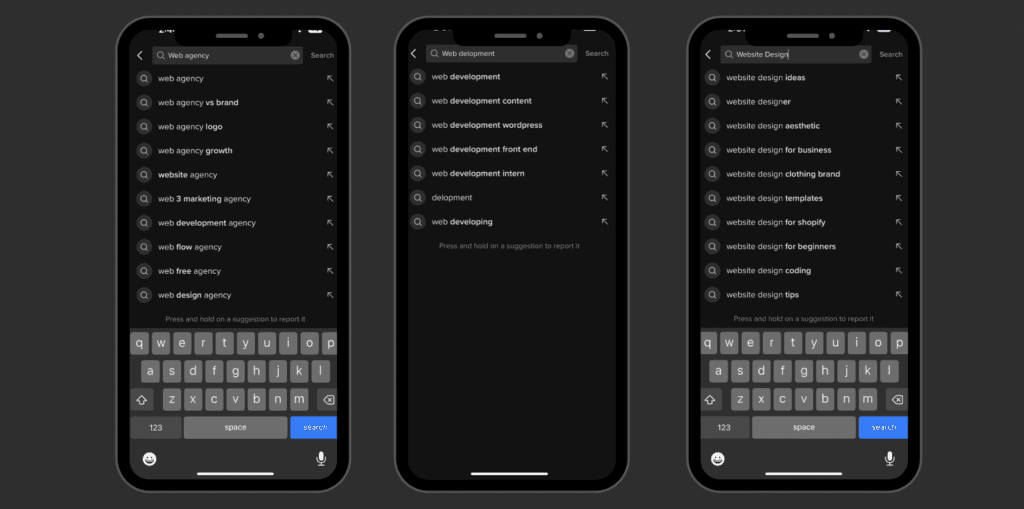
TikTok’s rapid growth has led to its evolution into a social media platform and search engine in its own lane. People often attribute their newfound knowledge to TikTok videos, highlighting the app’s increasing role as an information source. TikTok has become a preferred destination for online searches, covering everything from restaurant recommendations to beauty tricks and household cleaning tips.
Recognising the significance of TikTok’s search capabilities, creators and businesses should be mindful of TikTok SEO (search engine optimisation) to expand their reach on the platform. Employing various strategies can enhance the chances of having your videos featured prominently in TikTok’s search results. In this article, we’ll delve into some valuable tips to optimise your TikTok content for search success.

What is TikTok SEO?
The concept of search engine optimisation (SEO) extends far beyond Google, encompassing platforms like YouTube, Reddit, Quora, Instagram, Pinterest, and notably, TikTok, which has experienced a surge in popularity over the past year.
Reactive marketing offers an opportunity for creativity and engagement, often combined with humour or significance. The rise of TikTok SEO can be largely attributed to the growing trend among a younger demographic of users who now turn to TikTok for their informational and discovery-based search queries, rather than relying solely on Google. While TikTok was initially known for viral challenges and trending sounds, it has evolved into a dynamic search engine, offering a wide range of content, from fashion inspiration and recipes to job interview tips and even personal finance advice. The platform caters to numerous search queries, covering a number of different topics.
During an industry event in July 2022, Google’s senior vice president, Prabhakar Raghavan, emphasised that younger users tend to prefer visually engaging forms of search and discovery. Beyond just restaurant ideas, TikTok has become a valuable tool for finding tips, trends, recipes, entertainment, products, and a diverse range of information.
In today’s social media-centric landscape, younger consumers appear to be growing impatient with traditional search engines. The demand for short-form video content is on the rise, as it offers quick and concise answers to users’ queries. Additionally, the credibility of TikTok reviews and recommendations, being directly from content creators, has fostered trust among Generation Z users. This trust in sources is a key factor in TikTok isn’t just survival but thriving as a prominent search platform.

Why is TikTok SEO significant?
In today’s landscape, TikTok has gained prominence as a search engine, particularly among Generation Z, challenging Google’s dominance. As a result, creators aiming to expand their audience on TikTok must prioritise the discoverability of their content. To achieve this, having a well-planned TikTok SEO strategy is crucial.
Implementing SEO best practices plays a vital role in conveying the content’s essence to the TikTok algorithm, facilitating the matching of TikTok videos with potential viewers.
While there’s a possibility for videos to go viral without considering TikTok SEO, positioning posts for success, creators should proactively incorporate TikTok search considerations while crafting their content.

How does the TikTok algorithm rank videos?
Similar to algorithms on other platforms, TikTok’s algorithm endeavours to align the signals it receives from your content with what it believes TikTok users would be interested in viewing. This alignment can significantly impact the reach of your TikTok content in various ways:
- Visibility on the For You page (FYP) of other users
- Appearances in specific search results
- Rankings on both the For You page and TikTok search results
Now, let’s delve into how the algorithm collects information from your content and the type of data it examines. Let’s break it down step by step.
User activity
User activity plays a pivotal role in the complete TikTok SEO picture. The platform consistently gathers data concerning a user’s actions, encompassing their likes, shares, and comments, to anticipate the kind of content that will pique their interest.
The underlying motive is to ensure that TikTok users remain engaged for extended periods, prompting the TikTok team to deliver content that aligns with users’ preferences and keeps them captivated. By leveraging this valuable user data, TikTok aims to enhance user satisfaction and foster a thriving and immersive user experience on the platform.
Video information
Curious about the other half of the TikTok SEO equation? It’s none other than your very own TikTok videos.
Once the TikTok algorithm gathers sufficient user data and preferences, it aims to pair them with relevant content. This process involves extracting information such as meta data, hashtags, song titles, on-screen text, and captions, keywords from videos. If you strategically incorporate keywords into these elements that align with what a user is seeking, your TikTok content is more likely to be recommended to them. It becomes essential to pay extra attention when publishing content on TikTok.
Device and account settings
Another factor the TikTok algorithm takes into account is the user’s preferences set within the platform and other device-related information. Regarding account settings, TikTok considers language preferences and the type of content the user indicated interest in during their initial sign-up.
Moreover, TikTok leverages location data to personalise the content displayed in a user’s feed. For instance, if someone is from England but spends a weekend in New York City, their feed is likely to feature more content with New Yorker accents during that period.
Impacting TikTok SEO ranking factors: looking at key techniques
On-Screen Text: TikTok extracts crucial keywords from on-screen text to determine a video’s content. To optimise, include key search terms in your video text, ideally within the first 3-5 seconds to create an engaging video hook.
Captions: TikTok scans video captions for relevant keywords. Enhance optimization by incorporating key search terms in your captions. Research your audience’s niche and what they search for, and integrate these insights into your captions.
Hashtags: The same principle applies to hashtags. Include up to 10 hashtags in your captions, with 5 related to your audience’s niche and 5 more generic ones to broaden your reach.
Sound: TikTok’s API analyses sound and spoken words in videos to identify key terms and comprehend the video’s topic. For optimal results, speak your key words in the introductory part of your video, within the first 3-5 seconds.
Where to begin?
Start with your audience: Always prioritise understanding your target audience. Categorise them to gain clarity on your priority audience group.
Keyword research: Conduct thorough keyword research to discover the words or phrases your target audience uses when seeking content like yours. TikTok itself is a great starting point for this research, as it auto-populates the search bar with popular keywords related to your query. Select relevant keywords from the suggestions and integrate them into your content.
Utilise these strategies, monitor your progress, and adjust based on insights. With time and effort, you’ll be well on your way to success!

